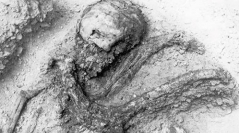

 Comptes Rendus Palevol
5 (1-2) - Pages 161-167
Comptes Rendus Palevol
5 (1-2) - Pages 161-167Burials are the only one of the multiple practices used in funerary purposes that can be interpreted by archaeologists without ambiguity. Normally, it is easy to recognise a burial, even if the limits of the grave have disappeared. If the skeleton is preserved in anatomical position or if the bones are bundled together in a small place a human intervention to protect them can be inferred. The most ancient burials have been found in the Near East in the caves of Qafzeh (95 ± 5 kyr) and Skhul (101 ± 12 kyr). It is possible that the Tabun-1 burial (Israel) is older (165 ± 16 kyr), but its stratigraphic position and the age of the layer in which it was uncovered are uncertain. If Tabun is the oldest, it is a Neandertal burial; if the oldest are those of Skhul and Qafzeh, they are morphologically modern human burials. But, more importantly, in all these cases, the burials are associated with artefacts of the Mousterian culture. The custom of burying the dead was ‘invented’ by the Mousterians. During tens of millennia, the burials were limited to the Mousterian culture before to diffusing, together with the Upper Palaeolithic implements, all over the world. Males, females and children were buried, but only a very few individuals seemed to have received this particular treatment. We know of a maximum of 30 Mousterian burials; however, the remains of more than 400 individuals have been discovered. At the very least, these burials demonstrate that Mousterian people had some respect for the dead. But, when offerings are part of the internment, like the antler over the hands of the Qafzeh 11 adolescent, the burial appears to have greater significance. Even in these cases, however, it is difficult to associate this as part of a religious ritual. Burial is not a mark of religiosity, but of social practices. Even if we suspect that there was a belief in an afterlife, this does not offer proof of the presence of religion. Finally, the diversity of the burials in the Mousterian probably means that the cultural diversity of this widespread Middle Palaeolithic civilisation was greater than it appears from the technological remains.
Burials, Mousterian, Near East, Neandertals, modern Humans